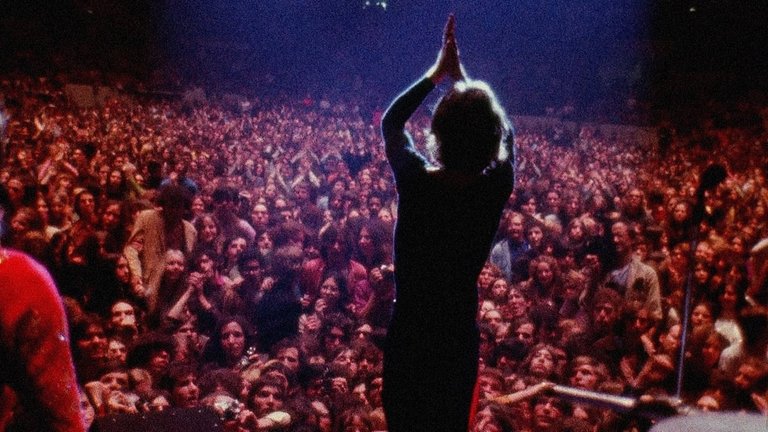Film Review: Gimme Shelter (1970)

Michael Wadleigh’s Woodstock (1970) is frequently lauded as the quintessential rockumentary, a euphoric chronicle of peace, music, and communal utopia. Yet, for those seeking not just nostalgic reverie but a deeper interrogation of the 1960s counterculture, its spiritual successor—and grim antithesis—offers a far more sobering perspective. Gimme Shelter, released the same year and directed by Albert and David Maysles alongside Charlotte Zwerin, documents the Rolling Stones’ ill-fated 1969 US tour, culminating in the catastrophic Altamont Free Concert. Where Woodstock immortalised the decade’s idealism, Gimme Shelter captures its unravelling, serving as a visceral requiem for an era.
Conceived as a triumphant finale to the Stones’ American tour, the Altamont concert was intended to emulate Woodstock’s mythic success, positioning the band—then at their zenith—as countercultural icons. Yet, from its inception, the event was plagued by hubris and logistical chaos. Originally planned for San Francisco, authorities’ fears over crowd control forced a last-minute relocation to the Altamont Speedway, a desolate venue ill-suited for 300,000 attendees. Compounding this disarray was the band’s calamitous decision to enlist the Hells Angels as security, paying them in beer—a choice that epitomised the naivety of conflating outlaw romanticism with practical governance.
The Angels’ intoxicated brutality, juxtaposed against an audience altered by bad drugs and escalating tension, transformed the concert into a vortex of violence. The nadir came with the fatal stabbing of 18-year-old Meredith Hunter by Angel Alan Passaro, captured in chilling detail by the Maysles’ cameras. Altamont’s descent into chaos not only shattered the illusion of a harmonious “Woodstock Nation” but signalled the death knell of 1960s idealism, exposing the fragility of its utopian aspirations.
Comparisons between Woodstock and Gimme Shelter are inevitable, not least due to shared participants like promoter Michael Lang and Jefferson Airplane, whose Altamont set was interrupted when singer Marty Balin was assaulted by an Angel. Yet the films diverge starkly in tone and intent. Where Woodstock revelled in the spectacle of communal euphoria, Gimme Shelter adopts the unflinching gaze of a post-mortem. The Maysles and Zwerin, pioneers of the Direct Cinema movement, eschew narration and editorialising, allowing the raw footage—of Jagger’s faltering stage presence, the Angels’ menacing patrols, and Hunter’s final moments—to indict the era’s contradictions.
The film’s innovative structure amplifies its thematic resonance. Opening with the Stones reviewing footage of Altamont in a editing suite—a meta-cinematic device rare for its time—it juxtaposes their retrospective shock with the tour’s initial exuberance. Early scenes of electrifying Madison Square Garden performances, where Jagger commands the stage with Dionysian flair, lull viewers into a false sense of nostalgia. Yet this preamble serves as a deliberate foil, contrasting the tour’s professional sheen with the anarchic unraveling at Altamont.
When the film shifts to the Speedway, the idyllic trappings of Woodstock—the sea of youths, the haze of drugs—are subverted by a palpable unease. The bleak December cold, the shambolic infrastructure, and the prevalence of methamphetamine (as opposed to Woodstock’s LSD) render the crowd volatile. Jagger’s increasingly desperate pleas for calm—“Why are we fighting?”—echo futilely, his ethereal stage persona crumbling under the weight of real-world chaos. The closing scenes of helicopters evacuating the band, mirroring the imagery of Saigon’s fall, and the dazed exodus of attendees, evoke not a celebration but a retreat.
Critically, Gimme Shelter is not without imperfections. Its extended focus on the Madison Square Garden performances, while thematically purposeful, risks diluting the narrative urgency, potentially disorienting viewers anticipating a linear descent into tragedy. Yet this structural choice ultimately underscores the film’s central thesis: the dissonance between the Stones’ mythic stature and the grim reality they inadvertently orchestrated.
Moreover, the documentary’s historical significance transcends cinematic critique. During editing, the crew discovered the crucial frame-by-frame sequence of Hunter’s death, inadvertently captured by a camera operator. This footage, entered as evidence in Passaro’s 1971 trial, secured his acquittal on grounds of self-defence. Here, the film transcends its role as cultural artefact, becoming a forensic document that shaped real-world justice.
The film’s haunting coda—Jagger in the editing suite, muttering “That’s it” as Hunter’s death plays on loop—serves as the era’s definitive epitaph. This moment of horrified introspection mirrors Peter Fonda’s “We blew it” in Easy Rider (1969), distilling the collective disillusionment of a generation. For the Stones, Altamont marked a pyrrhic victory; their career endured, but their image as countercultural emissaries was irrevocably tarnished.
Gimme Shelter endures not merely as a record of failure but as a masterclass in reflexive documentary. Its unvarnished portrayal of Altamont’s chaos, coupled with its structural ingenuity, influenced subsequent works like Paradise Lost (1996) and The Act of Killing (2012), which similarly implicate their subjects in their own narratives. The film’s power lies in its refusal to sanitise or sentimentalise, instead presenting the 1960s’ demise as both inevitable and self-inflicted.
In the pantheon of rock documentaries, Gimme Shelter stands apart—a harrowing counterpoint to Woodstock’s mythmaking. It is a film that captures the precise moment the music died, not with a whimper, but a scream.
RATING: 7/10 (+++)
Blog in Croatian https://draxblog.com
Blog in English https://draxreview.wordpress.com/
InLeo blog https://inleo.io/@drax.leo
Hiveonboard: https://hiveonboard.com?ref=drax
InLeo: https://inleo.io/signup?referral=drax.leo
Rising Star game: https://www.risingstargame.com?referrer=drax
1Inch: https://1inch.exchange/#/r/0x83823d8CCB74F828148258BB4457642124b1328e
BTC donations: 1EWxiMiP6iiG9rger3NuUSd6HByaxQWafG
ETH donations: 0xB305F144323b99e6f8b1d66f5D7DE78B498C32A7
BCH donations: qpvxw0jax79lhmvlgcldkzpqanf03r9cjv8y6gtmk9
Posted Using INLEO